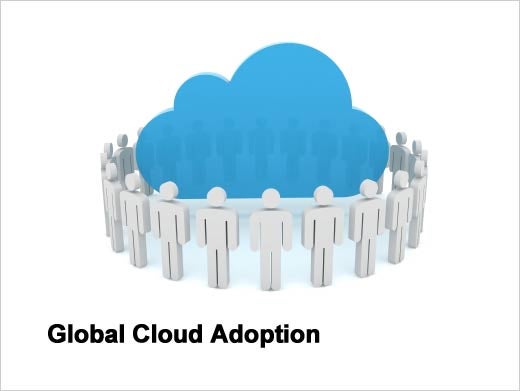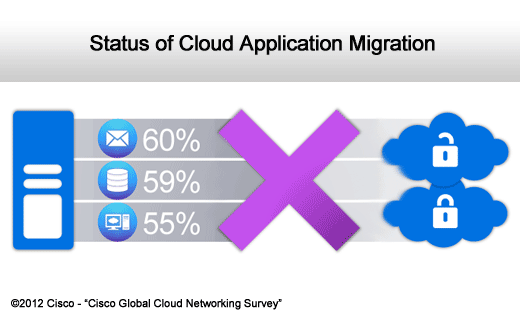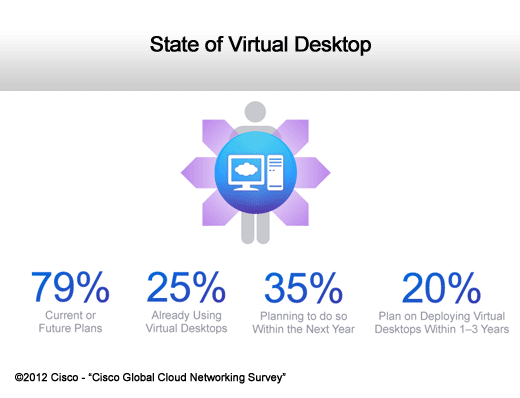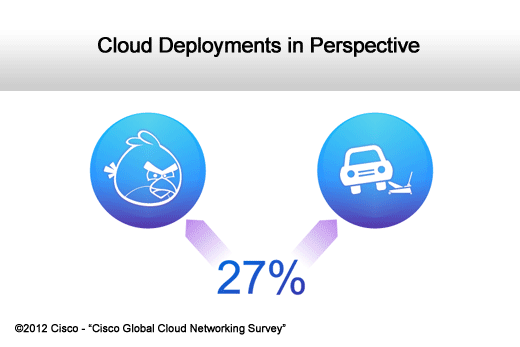
A new global survey of 1,300 IT professionals, conducted by Cisco, finds that not only does it take about six months to deploy a cloud application, but a fair number said they would be more likely to see a UFO in the next six months than they were to complete a cloud migration project.
Click through for results from a cloud adoption survey conducted by Cisco.
If given the choice of only being able to move one application to the cloud, most respondents would choose storage, followed by Enterprise Resource Planning (ERP) applications to manage HR, customer relationship management, supply chain management, and project management systems. Email and collaboration solutions followed.
When asked which applications have been moved, or are being planning to be moved to public or private clouds in the next year, the majority of IT decision makers cited email and Web services, followed by storage and collaboration solutions such as Web conferencing and instant messaging.
For IT managers whose cloud migrations are still taking place, the application that most decided to not move to the cloud (private or public) — although expressing a desire to do so — were email, storage and virtual desktops.
During the cloud migration process, availability/reliability of cloud applications was cited as one of the top network challenge for preventing a successful implementation of cloud services, followed by device-based security and cloud application performance.
Presently, only 5 percent of IT decision makers have been able to migrate at least half of their total applications to the cloud. By the end of 2012, that number is expected to significantly rise, as more than one in five (20 percent) will have deployed over half of their total applications to the cloud.
When asked to anticipate the length of time the transfer of applications such as Web conferencing, storage and email would take to either private or public clouds, most respondents anticipated a private cloud migration to take longer than a public one. In addition, when asked to estimate the average length of time it would take to complete the cloud migration for their applications, most IT professionals indicated the deployment would take less than six months.
In order to successfully move more applications to the cloud, the majority of respondents cited a cloud-ready network as the biggest infrastructure element required for further cloud deployments, ahead of a virtualized data center or a service-level agreement from a cloud service provider.
When asked about their plans to deploy virtual desktops, 79 percent of IT decision makers cited it as part of their current or future plans. 25 percent are already using virtual desktops, with 35 percent planning to do so within the next year. 20 percent plan on deploying virtual desktops within one to three years.
Among the top barriers to keeping virtual desktop deployments from taking place, respondents cited cost as the primary obstacle, followed by bandwidth requirements, virtual desktop (VDI) performance caused by WAN latency, integration of native with virtual desktops, and the overall complexity of the deployment.
When asked the reason behind their move to the cloud, 52 percent of respondents claimed it was an imperative made by their business or CIO to in order to improve costs, productivity and agility. 41 percent said they’re simply following the industry or their peers, while 30 percent are doing so because of customer requirements.
Nearly two in five participants said they would not trust their own personal information — such as medical records and Social Security numbers — with the cloud provider they are currently using.
More than half of IT decision makers said they have a better overall application experience at home with their personal networks than they do at work.
Almost two in five of those surveyed said they would rather get a root canal, dig a ditch, do their own taxes than address network challenges associated with public or private cloud deployments.
More than one quarter said they have more knowledge on how to play Angry Birds — or know how to change a spare tire — than the steps needed to migrate their company’s network and applications to the cloud.
Nearly one quarter of IT decision makers said that over the next six months, they are more likely to see a UFO, a unicorn or a ghost before they see their company’s cloud migration starting and finishing.
More than one quarter said they could train for a marathon or grow a mullet in a shorter period of time than it would take to migrate their company’s applications to the cloud.
Nearly one quarter think the odds are better for them to be struck by lightning than have their cloud applications breached by an unwanted third party.




















